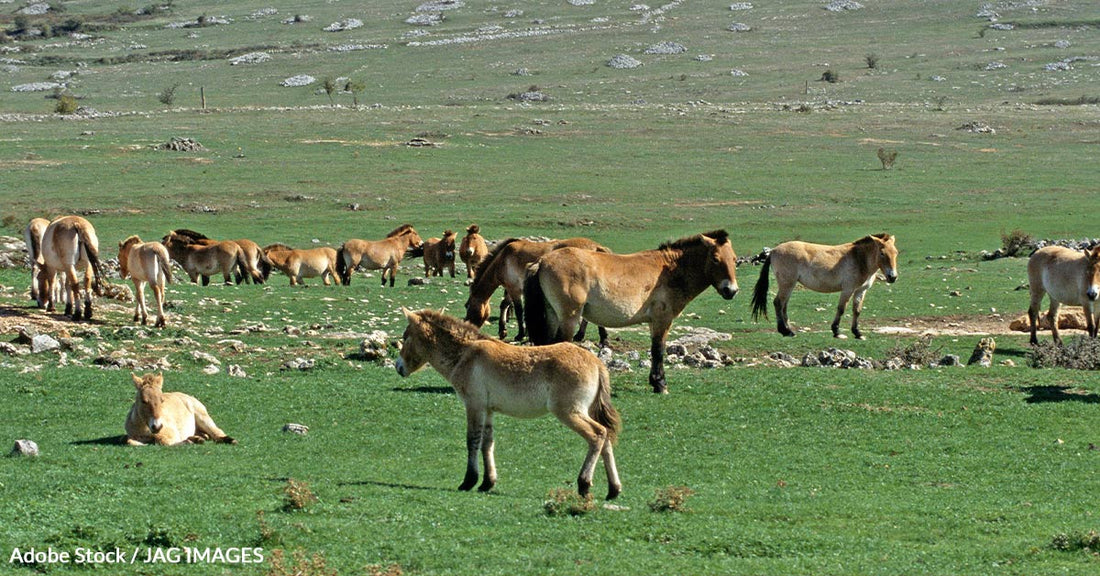Wild Horses Return to Kazakhstan in Stunning Conservation Triumph
Matthew Russell
In a remarkable comeback, Przewalski’s horses have returned to the Golden Steppe of Kazakhstan after nearly two centuries of absence.
This historic reintroduction effort, spearheaded by Prague Zoo and supported by international conservation organizations, marks a significant milestone in wildlife conservation.

A Journey Back Home
In early June, a group of seven Przewalski’s horses, consisting of one stallion and six mares, embarked on a 6,000-kilometer journey from Europe to Kazakhstan.
The horses, originating from zoos in Prague and Berlin, were transported on Czech Army planes, making stopovers in Turkey and Azerbaijan before arriving at Arkalyk Airport in Kazakhstan, the BBC reports. From there, they traveled another seven hours by truck to their final destination on the Altyn Dala, also known as the Golden Steppe.

Adapting to the New Environment
Upon arrival, the horses were placed in a 60-hectare acclimatization pen where they will spend their first year learning to navigate the harsh steppe environment. This enclosure will help them adapt to finding food and water, especially during the brutal winters typical of the region.
Filip Mašek, a spokesperson for Prague Zoo, told the BBC. that he felt optimistic about the horses’ initial adaptation, noting that they had begun to explore their new surroundings and even started mating.

The Last True Wild Horses
Przewalski’s horses are the last truly wild horse species in the world. Unlike mustangs or brumbies, which are feral descendants of domesticated horses, Przewalski’s horses have never been domesticated.
As The Guardian reports, they are shorter and stockier than modern horses and exhibit distinct genetic differences. Named after Russian explorer Nikolai Przewalski, who first described them to the European scientific community in the late 19th century, these horses once roamed extensively across Central Asia.

Historical and Cultural Significance
The return of Przewalski’s horses to Kazakhstan is not just a conservation success but also a restoration of cultural heritage. Archaeological evidence shows that people in northern Kazakhstan were riding and using these horses for food at least 2,000 years before domesticated horses appeared in Europe, the BBC reports.
The horses’ reintroduction reconnects the region with a significant part of its ancient history.
Conservation and Biodiversity
The reintroduction of Przewalski’s horses plays a crucial role in enhancing biodiversity on the Kazakh steppe. These horses contribute to the ecosystem by spreading seeds through their dung and helping to aerate the soil as they dig up plants. As Reuters reports,
This natural fertilization process supports the growth of diverse plant species and improves the health of the steppe environment. Albert Salemgareyev, a specialist with the Association for the Conservation of Biodiversity in Kazakhstan, emphasized the importance of these horses in maintaining the ecological balance.

The Long Road to Reintroduction
The journey to reintroduce Przewalski’s horses to Kazakhstan has been long and complex. The species went extinct in the wild by the end of the 1960s due to hunting, habitat loss, and competition with livestock. However, they survived in captivity, with key populations maintained in zoos across Europe. Prague Zoo, which manages the global studbook for the species, has been instrumental in breeding and reintroducing these horses to their natural habitats, The Guardian reports. Previous successful reintroductions in Mongolia have paved the way for the current efforts in Kazakhstan.
Looking Ahead
The initial reintroduction of seven horses is just the beginning. Over the next five years, Prague Zoo plans to transport around 40 more Przewalski’s horses to Kazakhstan. This ambitious project aims to establish a stable population that can thrive independently in the wild. Miroslav Bobek, director of Prague Zoo, described the horses’ arrival to Reuters as the start of a new chapter in the story of the last wild horse on the planet.

